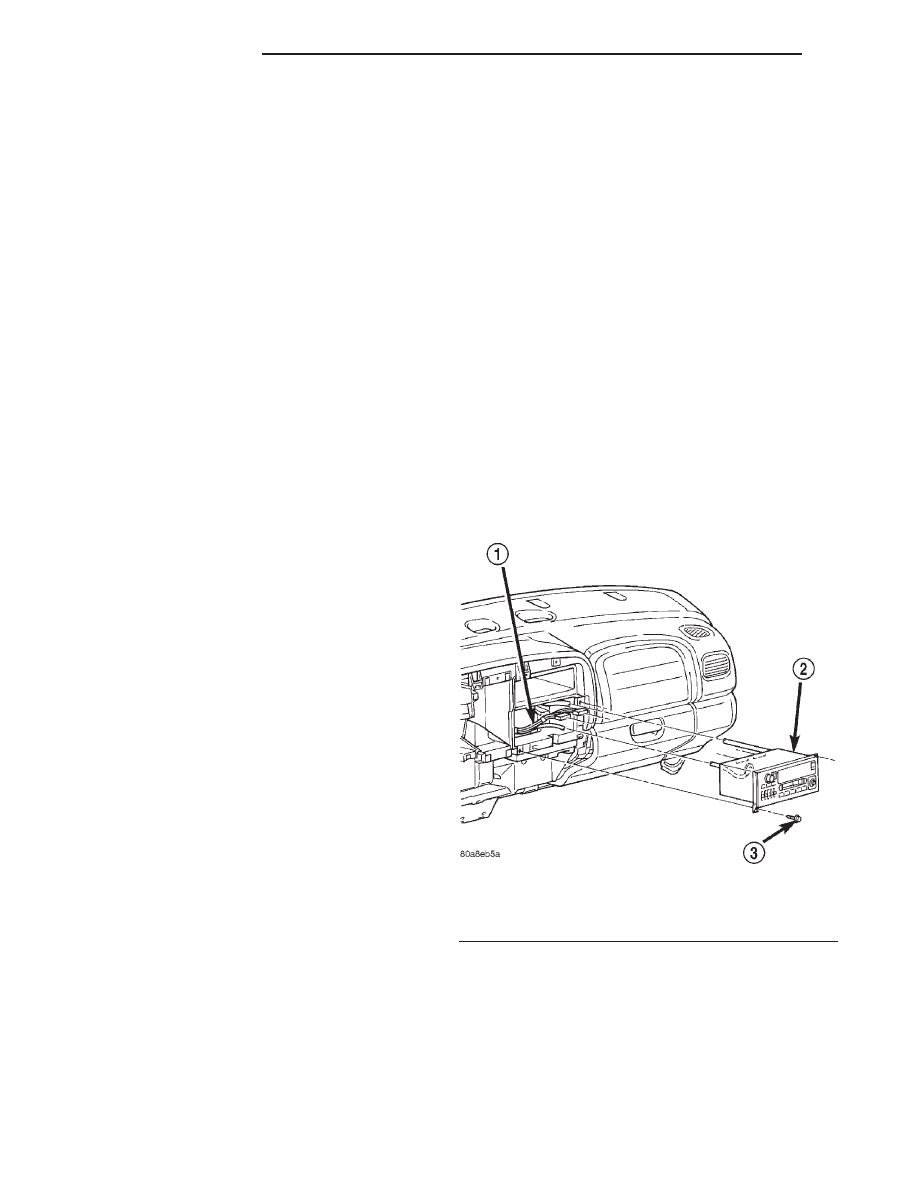Dodge Durango (DN). Manual - part 287

For complete circuit diagrams, see Group 8W -
Wiring Diagrams. Inspect the ground paths and con-
nections at the following locations:
• Blower motor
• Electric fuel pump
• Engine-to-body ground strap(s)
• Generator
• Ignition module
• Radio antenna base ground
• Radio receiver chassis ground wire or strap
• Wiper motor.
If the source of RFI or EMI noise is identified as a
component on the vehicle (i.e., generator, blower
motor, etc.), the ground path for that component
should be checked. If excessive resistance is found in
any ground circuit, clean, tighten, or repair the
ground circuits or connections to ground as required
before considering any component replacement.
For service and inspection of secondary ignition
components, refer to the Diagnosis and Testing sec-
tion of Group 8D - Ignition Systems. Inspect the fol-
lowing secondary ignition system components:
• Distributor cap and rotor
• Ignition coil
• Spark plugs
• Spark plug wire routing and condition.
Reroute the spark plug wires or replace the faulty
components as required.
If the source of the RFI or EMI noise is identified
as two-way mobile radio or telephone equipment,
check the equipment installation for the following:
• Power connections should be made directly to
the battery, and fused as closely to the battery as
possible.
• The antenna should be mounted on the roof or
toward the rear of the vehicle. Remember that mag-
netic antenna mounts on the roof panel can adversely
affect the operation of an overhead console compass,
if the vehicle is so equipped.
• The antenna cable should be fully shielded coax-
ial cable, should be as short as is practical, and
should be routed away from the factory-installed
vehicle wire harnesses whenever possible.
• The antenna and cable must be carefully
matched to ensure a low Standing Wave Ratio
(SWR).
Fleet vehicles are available with an extra-cost RFI-
suppressed Powertrain Control Module (PCM). This
unit reduces interference generated by the PCM on
some radio frequencies used in two-way radio com-
munications. However, this unit will not resolve com-
plaints of RFI in the commercial AM or FM radio
frequency ranges.
REMOVAL AND INSTALLATION
RADIO RECEIVER
WARNING: ON VEHICLES EQUIPPED WITH AIR-
BAGS,
REFER
TO
GROUP
8M
-
PASSIVE
RESTRAINT SYSTEMS BEFORE ATTEMPTING ANY
STEERING
WHEEL,
STEERING
COLUMN,
OR
INSTRUMENT PANEL COMPONENT DIAGNOSIS OR
SERVICE. FAILURE TO TAKE THE PROPER PRE-
CAUTIONS COULD RESULT IN ACCIDENTAL AIR-
BAG DEPLOYMENT AND POSSIBLE PERSONAL
INJURY.
REMOVAL
(1) Disconnect and isolate the battery negative
cable.
(2) Remove the cluster bezel from the instrument
panel. Refer to Cluster Bezel in the Removal and
Installation section of Group 8E - Instrument Panel
Systems for the procedures.
(3) Remove the two screws that secure the radio
receiver to the instrument panel (Fig. 4).
(4) Pull the radio receiver out from the instrument
panel far enough to access the instrument panel wire
harness connectors and the antenna coaxial cable
connector (Fig. 5).
(5) Disconnect the instrument panel wire harness
connectors and the antenna coaxial cable connector
from the receptacles on the rear of the radio receiver.
(6) Remove the radio receiver from the instrument
panel.
Fig. 4 Radio Receiver Remove/Install
1 – WIRE HARNESS
2 – RADIO
3 – SCREW
8F - 10
AUDIO SYSTEMS
DN
DIAGNOSIS AND TESTING (Continued)